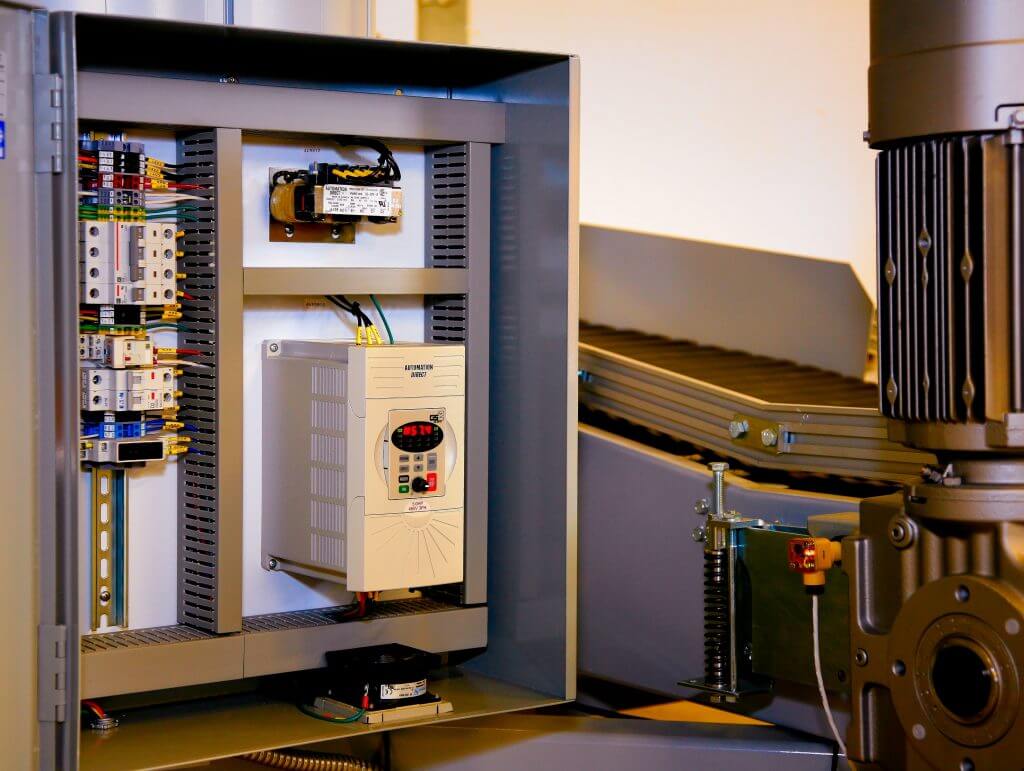Many VFDs now have on-board logic programming and I/O, enabling them to perform real-time control for localized applications.
Jeff Payne, Product Manager for the Drives & Motors Group at AutomationDirect, wrote an article for the April 2020 issue of Design News titled The Logic of Balancing VFDs and PLCs. Here’s a summary, click on the link above for the full text.
Many industrial automation projects use programmable logic controllers (PLCs) for executing programs and variable frequency drives (VFDs) for running AC motors at commanded speeds. Some of the latest VFDs are actually hybrids with PLC-like programming functionality built right in, giving end users new options when designing automated systems.
A VFD, and More
VFDs vary motor speed electrically and have been available about 50 years as a far superior alternative to older mechanical speed control methods. Beyond basic speed control, VFDs progressively gained features over the years like acceleration/deceleration, PID analog loop control, and closed-loop regulation of motor speed and torque. One significant benefit of using a VFD are energy savings realized by operating equipment at lower speeds to match load.

PLCs Bring the Brains
Much as VFDs deliver a better way of controlling motors, PLCs provide a superior automation option compared to classic hardwired control circuits. PLCs have been available for many decades, and their capabilities have progressed from basic on/off control to advanced logic and communications.
PLCs were the natural place to centralize control and visibility of processes, and VFDs continued in their motor control role. But ever-improving processing power, memory availability, communications options, and network speeds began to blur the line between the two.

Better Together: VFD + PLC
Original VFDs and PLCs where mission-specific devices, but advancements have led to overlapping capabilities, with PLCs gaining motion-control features and VFDs added logic programming. This was possible because the microprocessors used for both are very similar. Today, PLCs handle greater I/O counts and have more extensive logic command. However, VFDs can operate like micro-PLCs in many cases.
Finding a VFD/PLC Balance
For VFDs with PLC-like features, there are limitations for I/O count, logic and data memory, and available instructions. Logic programming within a VFD can give designers improved options for local/standalone operation, decreased or eliminated PLC hardware, and the ability to compartmentalize and replicate installation, commissioning, and startup activities.
VFDs can be the best choice for locally handling interlocks and basic control, with a supervisory PLC integrated to enable/disable operation and command operating setpoints if necessary.
However, if any of the noted limitations are exceeded, then the balance shifts in favor of using one or more centralized PLCs.
Smart VFDs in the Field
Many OEMs are finding intelligent programmable VFDs are a great way to combine motor control and logical control for zones of packaging equipment, and for smaller motor-focused systems like sump pump controls. Local controls can be easier for maintenance to troubleshoot.

A VFD Local Control Solution
Modern VFDs combine comprehensive motor control functionality with PLC features like programmability and I/O points. These intelligent VFDs are well suited for localized control and can also coordinate with supervisory systems, providing an economical and robust solution for many applications.

